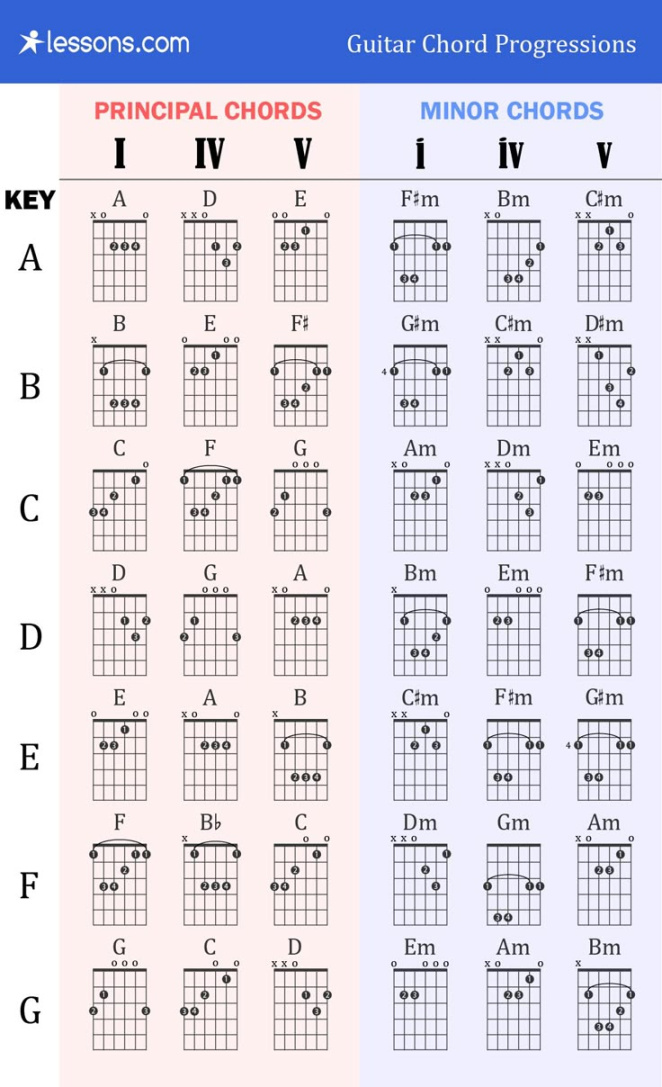—
Rockin’ Your Way Through Guitar Chord Progressions
So, you wanna write some rockin’ tunes, huh? Awesome! You’ve got your guitar, your amp’s humming, and you’re ready to rumble. But where do you start? Well, a solid foundation of chord progressions is your ticket to rock and roll glory. Let’s break down some killer progressions that’ll get you shredding in no time.
The Classic I-IV-V – Rock’s Bread and Butter

This is the granddaddy of rock progressions. Seriously, if you know this, you know a ton of rock songs. The I-IV-V progression is simple, versatile, and just plain rocks. What does that mean? Well, in the key of A, the I chord is A, the IV chord is D, and the V chord is E. So, you’d play A-D-E. Think of songs like “Louie, Louie” or “Wild Thing”—those are prime examples of this super-effective progression.
Why is it so popular? It’s just got that raw, powerful sound. It’s the musical equivalent of a leather jacket and a motorcycle. You can use it for anything from bluesy riffs to full-on stadium anthems. Try it out in different keys, too. The I-IV-V works in any key, just remember to keep the intervals right.
Minor Key Magic – The i-iv-V
Rock isn’t always sunshine and rainbows, right? Sometimes, you need that darker, more intense vibe. That’s where minor keys come in. The i-iv-V (lowercase “i” means minor chord) is your go-to for those brooding, epic rock sounds. In the key of A minor, that’s Am-Dm-E. Think of bands like Black Sabbath or Metallica. They love this kind of progression.
The minor key gives it that edge, that sense of drama. It’s perfect for power chords, driving rhythms, and those moments when you just want to let loose. Experiment with different voicings and rhythms within this progression. You can make it as heavy or as melodic as you want.
The 12-Bar Blues – Rock’s Soul
The 12-bar blues is a staple of rock, and it’s built on a specific chord progression. It’s usually I-IV-I-V-IV-I. Let’s stick with A: A-D-A-E-D-A. Now, you can add in sevenths, ninths, and all kinds of fancy chords to spice it up, but that basic structure is the heart of the blues and a lot of rock.
Think about bands like Led Zeppelin or Jimi Hendrix. They took the blues and turned it into rock gold. The 12-bar blues gives you a framework, but it’s up to you to add your own flavor. You can jam on it for hours, and it’ll never get old.
Descending Progressions – Emotional Depth
Sometimes, you want a progression that pulls at the heartstrings. Descending progressions are perfect for that. A common one is I-vi-IV-V. In A, that’s A-F#m-D-E. This progression has a beautiful, almost melancholic feel to it.
It’s great for those moments when you want to create a sense of longing or introspection. Think of songs with those big, sweeping choruses. This progression can really elevate your songwriting. Another good descending progression is I-vi-ii-V. In A it is A-F#m-Bm-E. The ii chord adds another layer of emotion.
Power Chords – The Rock Building Blocks
Let’s talk power chords. They’re the backbone of rock and metal. Power chords are essentially two-note chords, usually a root and a fifth, and they sound huge. You can use them in any of these progressions we’ve talked about.
For example, instead of playing a full A chord, play an A5 power chord (A and E). It’s simpler, but it packs a punch. Power chords are great for those driving riffs and those moments when you just want to let loose. Experiment with different rhythms and voicings using power chords.
Mixing it Up – Adding Your Own Spin
Don’t be afraid to experiment. Take these basic progressions and add your own twist. Change the order of the chords, add in passing chords, or try different rhythms. Rock is all about expression, so make it your own.
Listen to your favorite rock songs and try to figure out the chord progressions. You’ll start to see patterns and get a feel for what works. And don’t be afraid to make mistakes. Some of the best rock songs were born from happy accidents.
Putting It All Together – Writing Your Own Rock Anthem
Now that you’ve got some progressions under your belt, it’s time to write your own rock anthem. Start with a simple progression, like the I-IV-V, and build from there. Add in some power chords, experiment with different rhythms, and don’t be afraid to get loud.
Remember, rock is all about energy and emotion. Let your passion shine through in your playing, and you’ll be rocking out in no time.
Conclusion
Guitar chord progressions are the lifeblood of rock music. From the classic I-IV-V to the emotional depth of descending progressions, these structures provide the foundation for countless rock anthems. By understanding and experimenting with these progressions, you can unlock your own creative potential and write songs that resonate with power and passion. Don’t be afraid to mix things up, add your own spin, and most importantly, have fun. Rock and roll is all about expressing yourself, so pick up your guitar and let those chords ring out.

